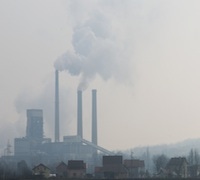Clean Coal: Future or Fossil?
Our world has a coal problem. In the United States, coal-burning power plants are the largest source of air pollution, while in China some reports peg coal-based air pollution as the culprit for the deaths of more than 1.2 million people in 2010.
 Beijing has plans to impose low-sulphur coal policies across all industries next month, but this won’t cure the underlying problem: Massive carbon dioxide emissions.
Beijing has plans to impose low-sulphur coal policies across all industries next month, but this won’t cure the underlying problem: Massive carbon dioxide emissions.
One possible solution is what’s known as “clean coal.” But is this technology the future of environmental stewardship, or doomed to become just another fossil fail?
What’s Old is New Again
First, it’s important to note that clean coal is not a physical substance, not something we can pull out of the ground and use to fuel power plants.
Instead, clean coal initiatives rely on technology designed to remove carbon dioxide from coal-burning byproducts. There are two frontrunners in this effort: Carbon capture and direct air capture.
Carbon capture works by redirecting flue gas just before it enters a power plant’s air stack. Next, a liquid solvent is introduced that strips CO2 from the gas.
In Kentucky, for example, the state’s first megawatt-scale carbon capture plant will release flue gas containing just two percent CO2. The solvent is then boiled off and recycled for use in capturing more carbon dioxide.
This capture technology may also prove useful in the oil industry, since catch-and-release CO2 can be used by oil companies to “loosen” and then extract oil from depleted oil fields, according to Sustainable Business.
Another Option
Direct air capture (DAC) is another possible solution. As described by David Keith of Harvard University, DAC “refers to a set of technologies that can capture industrial-scale quantities of CO2 from atmospheric air, as opposed to point-source CCS which captures only from flue stacks where CO2 is much more concentrated.”
While this technology is still maturing, it offers the possibility of capturing CO2 from any process and in any volume, rather than in the limited confines of flue stacks.
And as a recent Phys.org article notes, it may be possible to re-purpose DAC carbon dioxide for use as a third-generation biofuel.
Car manufacturer Audi is already designing a CO2-powered car. While electric cars are the current environmental favorite, Columbia University graduate student Diego Villarreal-Singer points out that large vehicles such as trains, planes and ships will still require high energy density fuels such as gasoline, or CO2.
Bottom line? The world needs more clean coal, and several initiatives are underway to both capture and reuse the most damaging waste product of coal-burning, CO2. Time and commercial viability will tell, however, if carbon capture and DAC are ideal solutions or mere stopgaps.
Next Steps:
- Subscribe to our blog to receive the full blog series via email and stay informed about the latest HVAC news and insight.
- Stay up to date on facility maintenance tools such as chiller tube cleaners, boiler tube cleaners, hose/pipe cleaners, descaler systems, industrial vacuums, commercial pressure washers, and drain cleaners.

